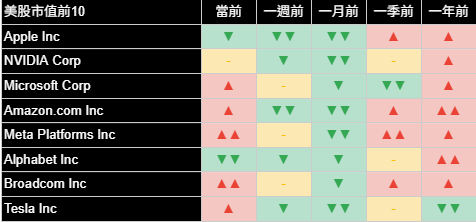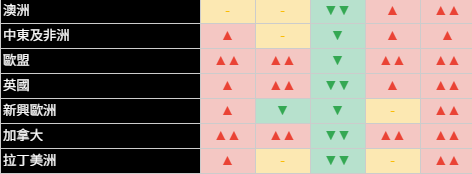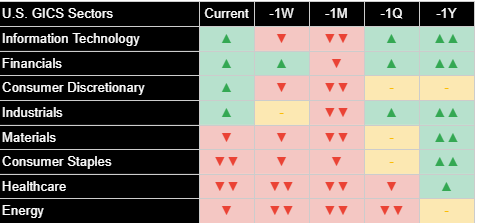【Joe’s華爾街脈動】輝達帶動科技股反彈,標普500指數抹去年度跌幅;關稅休兵之際CPI數據趨緩
市場樂見通膨降溫,科技股憑AI樂觀情緒大漲;道瓊指數受聯合健康拖累下跌
Joe Lu, CFA 2025年5月13日 美東時間
市場概況
美國股市週二延續上漲動能,標普500指數收復失地,重新站回今年以來的正報酬區間,投資者情緒在週一美中關稅休兵後持續樂觀,並進一步受到優於預期的四月份通膨報告所支撐。今日上午公布的消費者物價指數(CPI)年增2.3%,略低於預期的2.4%,暫時緩解市場對四月起實施關稅導致消費者物價急劇上揚的疑慮。儘管經濟學家認為,關稅的全面影響可能數月後才會顯現在CPI數據中,但今日的數據受到市場歡迎,並被視為給予美國聯準會在貨幣政策上維持觀望的空間。
整體市場的標普500指數上漲+0.66%,而以科技股為主的那斯達克綜合指數則顯著攀升+1.52%。然而,道瓊工業平均指數表現遠遠落後,下跌-0.64%(約270點),主要由於其成分股聯合健康 (UnitedHealth) 在其執行長意外離職,並撤回2025年財測後股價暴跌近18%。標普500指數轉為2025年正報酬,代表著其從四月初因貿易緊張局勢嚴重打擊投資者信心時的低點顯著回升。
今日科技類股上漲的關鍵推手為輝達 (NVIDIA),其股價在公司宣布將向沙烏地阿拉伯提供18,000顆頂級人工智慧晶片作為白宮主導計畫一部分的消息後,上漲+5.63%。此一涉及輝達先進GB300 Blackwell晶片用於新建置資料中心的發展,提振了博通 (Broadcom) (+4.89%) 和超微 (AMD) 等同業晶片股,市場對AI交易的熱情再度升溫。儘管美中關稅協議仍是一個重大的正面因素,但惠譽 (Fitch) 和凱投宏觀 (Capital Economics) 等機構的分析師警告,這並不意味著完全的「貿易正常化」。他們指出,即使有所削減,美國的有效關稅率仍處於歷史高位,且眾多潛在的衝突點可能在90天暫停期滿後導致緊張局勢再度升級。白宮亦宣布沙烏地阿拉伯另外承諾在美國投資6000億美元,重點關注科技和國防領域,進一步突顯了國際間的經濟磋商。
重點摘要
- 標普500指數 (+0.66%) 週二上漲,轉為今年以來正報酬,投資者延續週一因美中貿易緊張局勢緩解所帶動的強勁漲勢,並樂見優於預期的四月份CPI數據。
- 四月份CPI年增2.3%,低於預期,顯示關稅衝擊尚未普遍顯現於消費者物價;然而,市場衍生的通膨指標今日走強。
- 那斯達克綜合指數 (+1.52%) 領漲,受惠於輝達 (+5.63%) 宣布重大AI晶片協議後半導體股的大漲;道瓊指數 (-0.64%) 則受聯合健康股價急跌拖累。
- 儘管市場表現正面,分析師警告關稅不確定性依然存在。分析顯示投資存續期間仍極為不利,儘管消費者信心呈現中度正向。
- 市場焦點仍集中在即將公布的零售銷售和PPI數據,以進一步評估經濟韌性及關稅的真實影響。
主要市場指數

主要市場指數週二表現分歧,科技股領漲,而道瓊指數則受特定個股疲弱拖累。標普500指數上漲+0.66%,使其今年以來轉為正報酬。那斯達克綜合指數在半導體和大型科技股強勁表現的帶動下飆升+1.52%。相較之下,道瓊工業平均指數下跌-0.64%。代表小型股的羅素2000指數上漲+0.37%。市場走勢反映出對美中貿易休兵的持續樂觀情緒以及對四月份CPI數據的正面反應。
費城半導體指數表現突出,在輝達利多消息和整體科技股熱情的帶動下大漲+3.13%。此強勁漲幅進一步改善其近期技術面貌。
從分析角度來看,今日的漲勢使得標普500指數與那斯達克綜合指數的近期市場特性進一步改善,分析目前顯示兩者狀況均屬有利。然而,根據我們的指標,道瓊工業平均指數仍維持中性,而羅素2000指數則從中性轉為中度不利。此種分歧突顯了目前由科技股和大型成長股領軍的局面,而部分更廣泛的市場產業則信心不足。
美國前十大公司


美國大型企業週二表現強勁,科技類股尤為出色,受積極利多的消息和貿易緊張局勢緩解的持續提振。
觀察個股當日表現:輝達 (NVIDIA Corp) 在宣布與沙烏地阿拉伯達成重大AI晶片協議後飆升+5.63%。博通 (Broadcom Inc) 在半導體領域正面情緒的帶動下上揚+4.89%。特斯拉 (Tesla Inc) 上漲+4.93%。Meta Platforms Inc 上漲+2.60%。蘋果 (Apple Inc) 上漲+1.02%,亞馬遜 (Amazon.com Inc) 上漲+1.31%。微軟 (Microsoft Corp) 收盤微跌-0.03%。Alphabet Inc A股 (Alphabet Inc Class A) 上漲+0.68%。金融股表現好壞參半,摩根大通 (JPMorgan Chase & Co) 上漲+1.14%。波克夏海瑟威B股 (Berkshire Hathaway Inc Class B) 下跌-0.47%。
從底層分析面來看,多檔科技龍頭股的近期市場特性持續改善。分析目前顯示,微軟 (Microsoft Corp)、亞馬遜 (Amazon.com Inc)、Meta Platforms Inc、博通 (Broadcom Inc) 和特斯拉 (Tesla Inc) 的狀況有利。輝達 (NVIDIA Corp) 亦從先前的不利評估轉為中性。蘋果 (Apple Inc) 和Alphabet Inc A股 (Alphabet Inc Class A) 則維持中度不利狀態。摩根大通 (JPMorgan Chase & Co) 維持其有利評估,而波克夏海瑟威B股 (Berkshire Hathaway Inc Class B) 則維持中性。今日的價格走勢開始與這些關鍵個股中多檔改善後的分析讀數更為一致。
經濟指標

今日公布的關鍵經濟數據——四月份消費者物價指數(CPI)——為市場帶來正面驚喜,顯示通膨增長低於預期。CPI年增2.3%,低於經濟學家預期的2.4%,且較三月份的增長率有所放緩。此數據表明,四月份初步實施的關稅並未立即轉化為消費者物價的急劇上揚,為投資者和美國聯準會帶來些許寬慰。川普總統於社群媒體上強調通膨降溫,並再次呼籲聯準會降息。
然而,我們整套經濟指標今日呈現出更為細緻的景象。分析顯示,投資存續期間的訊號仍極為不利,表明儘管近期市場反彈,市場對較短投資期限的強烈偏好持續存在,整體不確定性居高不下。企業獲利前景維持中性。較為正面的是,消費者信心訊號維持在中度正向。值得注意的是,我們市場衍生的通膨指標今日從中性轉為中度正向,表明儘管四月份官方CPI數據較為溫和,市場參與者可能正在反映或預期未來通膨壓力將略微上揚。官方CPI數據與市場基礎的通膨訊號之間的分歧,加上極度保守的投資存續期間讀數,突顯了需要持續仔細評估的複雜環境。
類股概況


標普500指數各類股週二表現大多為正,儘管領漲力道明顯集中在科技和成長導向型領域,而部分防禦型和週期性類股則表現落後。
資訊科技類股 (+2.22%) 表現突出,受惠於半導體股(尤其是輝達)的強勁漲勢而飆升。非必需消費品類股 (+1.32%) 亦錄得穩健漲幅,受特斯拉和亞馬遜等個股推動。通訊服務類股 (+0.98%) 受惠於Meta和Alphabet的上漲。能源類股 (+1.41%) 反彈。工業類股 (+0.70%) 和金融類股 (+0.41%) 呈現溫和上漲。原物料類股 (-0.50%) 是週期性類股中顯著的下跌者。防禦型類股表現好壞參半:房地產類股 (-1.37%) 和必需消費品類股 (-1.37%) 表現最為疲弱,而公用事業類股 (-0.14%) 亦收低。醫療保健類股 (-3.01%) 則是表現最差的類股,跌幅顯著,主要受聯合健康股價急跌的嚴重影響。
從分析角度來看,今日的價格走勢進一步改善了多個關鍵成長型類股的近期特性。分析目前指出,資訊科技、金融、非必需消費品和工業類股的狀況有利。通訊服務和能源類股改善至中性狀態。然而,醫療保健類股轉為極為不利狀況,而必需消費品和房地產類股的評估亦分別惡化至極為不利和中度不利。公用事業類股則維持中度不利。此日益加劇的分歧突顯市場變得更具選擇性。
國際市場


國際市場週二表現好壞參半,投資者消化美國CPI數據,並持續評估美中貿易休兵的影響。美元走弱,當日下跌-0.86%。
已開發市場表現好壞參半:歐洲股市上漲+0.40%,而日本股市則下跌-0.76%。美元走弱可能為歐洲資產提供部分支撐。分析持續顯示,從長期觀察來看,這些地區的潛在正向特徵正在增強。
新興市場亦呈現分化:新興亞洲市場近乎持平,下跌-0.08%。印度下跌-0.57%。拉丁美洲上漲+2.40%,表現強勁。中國股市下跌-0.65%。不同的表現反映出各區域對美國通膨數據、美元走勢和持續貿易情緒的敏感度各異。
其他資產
週二其他資產類別的活動反映了來自CPI數據和科技股反彈的正面情緒,隨著通膨擔憂略微緩解、風險偏好回升,債券普遍遭拋售(價格下跌,殖利率上升)。美元走弱亦對大宗商品價格產生影響。
固定收益方面,受CPI數據趨緩影響,美國公債價格全線下跌,殖利率隨之上揚,降低了市場對避險資產的即時需求。短期公債價格下跌-0.02%,中期公債價格下跌-0.07%,長期公債價格下滑-0.41%。整體美國綜合債券價格下跌-0.10%。
受美元走弱提振,大宗商品表現大多為正。WTI原油上漲+2.94%。黃金價格上漲+0.43%。基本金屬上漲+0.81%。農產品亦上漲+1.44%。美元指數顯著走弱,下跌-0.86%。在數位資產方面,比特幣價格受惠於風險情緒改善而飆升+3.01%。
立即加入《Joe’s 華爾街脈動》LINE@官方帳號,獲得最新專欄資訊(點此加入)
關於《Joe’s 華爾街脈動》
鉅亨網特別邀請到擁有逾 22 年美國投資圈資歷、CFA 認證的機構操盤人 Joseph Lu 擔任專欄主筆。 Joe 為台裔美國人,曾管理超過百億美元規模的基金資產,並為總資產高達數千億美元的多家頂級金融機構提供資產配置優化建議。 Joe 目前帶領著由美國頂尖大學教授與博士組成的精英團隊,透過獨家開發的 "趨勢脈動 TrendFolios® 指標",為台灣投資人深度解析全球市場脈動,提供美股市場第一手專業觀點,協助投資人掌握先機。
S&P 500 Wipes Out 2025 Loss as Nvidia Powers Tech Rally; CPI Eases Amid Tariff Truce
Markets Cheer Softer Inflation, Tech Surges on AI Optimism; Dow Lags on UnitedHealth Plunge
Joe Lu, CFA May 13, 2025
MARKET OVERVIEW
U.S. equity markets continued their upward momentum on Tuesday, with the S&P 500 clawing back into positive territory for the year, as investor sentiment remained buoyant following Monday's U.S.-China tariff truce and was further supported by a softer-than-expected April inflation report. The Consumer Price Index (CPI) released this morning showed a 2.3% year-over-year increase, slightly below the 2.4% anticipated, providing some relief to concerns that tariffs implemented in April would immediately translate into sharply higher consumer prices. While economists suggest the full tariff impact may not appear in CPI data for some months, today's reading was well-received and seen as giving the Federal Reserve more room to remain patient on monetary policy.
The broad market S&P 500 Index gained +0.66%, while the technology-heavy Nasdaq Composite Index climbed significantly by +1.52%. The Dow Jones Industrial Average, however, lagged considerably, losing -0.64% (approximately 270 points), primarily due to a near 18% plunge in shares of heavyweight component UnitedHealth following the unexpected departure of its CEO and a withdrawal of its 2025 guidance. The S&P 500's move into positive territory for 2025 marks a notable turnaround from its lows in early April when trade tensions had significantly dented investor confidence.
A key driver for the tech sector's outperformance today was NVIDIA, whose shares advanced +5.63% on news that the company would send 18,000 of its top artificial intelligence chips to Saudi Arabia as part of a White House-led initiative. This development, involving Nvidia's advanced GB300 Blackwell chips for a new data center, boosted peer chip stocks like Broadcom (+4.89%) and AMD, rekindling enthusiasm for the AI trade. While the U.S.-China tariff agreement remains a significant positive, analysts from firms like Fitch and Capital Economics caution that it doesn't signify complete "trade normalization." They note that the effective U.S. tariff rate remains historically high even with the reductions, and numerous potential flashpoints could lead to re-escalation when the 90-day pauses expire. The White House also announced a separate $600 billion investment commitment from Saudi Arabia in the U.S., focused on technology and defense, further highlighting international economic discussions.
EXECUTIVE SUMMARY
- The S&P 500 Index (+0.66%) rose Tuesday, turning positive for the year, as investors extended Monday's sharp gains driven by easing U.S.-China trade tensions and welcomed softer-than-expected April CPI data.
- April CPI rose 2.3% year-over-year, below expectations, suggesting tariff impacts are not yet broadly evident in consumer prices; however, market-derived inflation indicators firmed today.
- The Nasdaq Composite (+1.52%) led gains, fueled by a surge in semiconductor stocks after Nvidia (+5.63%) announced a major AI chip deal; the Dow (-0.64%) was pressured by a steep drop in UnitedHealth.
- Despite the positive market action, analysts caution that tariff uncertainty persists. Analysis shows Investment Duration remains pronouncedly unfavorable, though Consumer Strength is moderately positive.
- Focus remains on upcoming retail sales and PPI data to further gauge economic resilience and the true impact of tariffs.
BROAD MARKET INDICES

Broad market indices showed a divergence on Tuesday, with technology leading gains while the Dow was weighed down by specific stock weakness. The S&P 500 Index gained +0.66%, pushing it into positive territory for the year. The Nasdaq Composite Index surged +1.52%, driven by strong performance in semiconductor and large-cap tech stocks. In contrast, the Dow Jones Industrial Average fell -0.64%. The Russell 2000 Index, representing small-cap stocks, gained +0.37%. The market action reflected continued optimism from the U.S.-China trade truce and positive reaction to the April CPI data.
The PHLX Semiconductor Index was a standout performer, rallying +3.13% following the Nvidia news and broader tech enthusiasm. This strong gain further improves its near-term technical picture.
From an analytical perspective, today's gains led to a further improvement in the near-term market character for the S&P 500 and Nasdaq Composite, with analysis now indicating favorable conditions for both. The Dow Jones Industrial Average, however, remained neutral according to our indicators, while the Russell 2000 Index moved from neutral to moderately unfavorable. This divergence highlights the current leadership from technology and large-cap growth, while some broader market segments show less conviction.
TOP 10 U.S. COMPANIES

Performance among the largest U.S. companies was strong on Tuesday, particularly within the technology sector, driven by positive news flow and continued relief from easing trade tensions.
Looking at individual stock performance for the day: NVIDIA Corp surged +5.63% after announcing a significant AI chip deal with Saudi Arabia. Broadcom Inc climbed +4.89%, benefiting from the positive sentiment in the semiconductor space. Tesla Inc gained +4.93%. Meta Platforms Inc rose +2.60%. Apple Inc added +1.02%, and Amazon.com Inc gained +1.31%. Microsoft Corp finished slightly lower by -0.03%. Alphabet Inc Class A gained +0.68%. Financials were mixed, with JPMorgan Chase & Co up +1.14%. Berkshire Hathaway Inc Class B fell -0.47%.
Interpreting the underlying analytical picture, the near-term market character for several of these tech leaders continued to improve. Analysis now shows favorable conditions for Microsoft Corp, Amazon.com Inc, Meta Platforms Inc, Broadcom Inc, and Tesla Inc. NVIDIA Corp also moved to a neutral assessment from previously unfavorable. Apple Inc and Alphabet Inc Class A remained in a moderately unfavorable state. JPMorgan Chase & Co maintained its favorable assessment, while Berkshire Hathaway Inc Class B stayed neutral. Today's price action is beginning to align more closely with improved analytical readings for a number of these key names.
ECONOMIC INDICATORS

Today's key economic release, the April Consumer Price Index (CPI), provided a positive surprise for markets, indicating that inflation rose less than anticipated. The CPI increased 2.3% year-over-year, below the 2.4% economists expected and a slowdown from March's rate. This data suggests that the initial implementation of tariffs in April did not immediately translate into sharply higher consumer prices, offering some relief to investors and the Federal Reserve. President Trump highlighted the cooling inflation on social media, again calling for the Fed to lower interest rates.
Our suite of economic indicators, however, presented a more nuanced picture today. Analysis revealed that the Investment Duration signal remained pronouncedly unfavorable, indicating a persistent strong preference for shorter investment horizons and reflecting ongoing high levels of uncertainty despite the recent market rally. The Corporate Earnings outlook stayed neutral. On a more positive note, the Consumer Strength signal held at moderately positive. Interestingly, our market-derived Inflation indicator shifted from neutral to moderately positive today, suggesting that despite the softer official CPI print for April, market participants may be pricing in or anticipating a slight uptick in inflationary pressures going forward. This divergence between the official CPI data and market-based inflation signals, alongside the deeply cautious Investment Duration reading, underscores the complex environment that requires careful ongoing assessment.
SECTOR OVERVIEW


Sector performance within the S&P 500 was mostly positive on Tuesday, though leadership was clearly concentrated in technology and growth-oriented areas, while some defensive and cyclical sectors lagged.
Information Technology (+2.22%) was the standout performer, surging on the back of strong gains in semiconductor stocks, particularly Nvidia. Consumer Discretionary (+1.32%) also posted a solid gain, driven by names like Tesla and Amazon. Communication Services (+0.98%) benefited from gains in Meta and Alphabet. Energy (+1.41%) rebounded. Industrials (+0.70%) and Financials (+0.41%) saw moderate advances. Materials (-0.50%) was a notable decliner among cyclical sectors. Defensive sectors showed mixed results: Real Estate (-1.37%) and Consumer Staples (-1.37%) were among the weakest performers, while Utilities (-0.14%) also finished lower. Healthcare (-3.01%) was the worst-performing sector by a significant margin, heavily impacted by the sharp drop in UnitedHealth.
From an analytical perspective, today's price action led to further improvements in the near-term character for several key growth sectors. Analysis now indicates favorable conditions for Information Technology, Financials, Consumer Discretionary, and Industrials. Communication Services and Energy improved to a neutral state. However, Healthcare moved to a pronouncedly unfavorable condition, while Consumer Staples and Real Estate also saw their assessments worsen to pronouncedly unfavorable and moderately unfavorable, respectively. Utilities remained moderately unfavorable. This increasing divergence underscores a market becoming more selective.
INTERNATIONAL MARKETS


International markets displayed mixed performance on Tuesday as investors digested the U.S. CPI data and continued to assess the implications of the U.S.-China trade truce. The U.S. Dollar weakened, falling -0.86% for the day.
Developed markets were mixed: European equities gained +0.40% while Japanese equities fell -0.76%. The weaker dollar likely provided some support for European assets. Analysis continues to indicate underlying strengthening positive characteristics for these regions over longer horizons.
Emerging markets also showed varied results: Emerging Markets Asia was nearly flat, down -0.08%. India fell -0.57%. Latin America gained +2.40%, showing significant strength. Chinese equities declined -0.65%. The varied performance reflects differing regional sensitivities to U.S. inflation data, dollar movements, and ongoing trade sentiment.
OTHER ASSETS
Activity across other asset classes on Tuesday reflected the positive sentiment from the CPI data and tech rally, with bonds generally selling off (prices lower, yields higher) as inflation fears eased slightly and risk appetite improved. The weaker dollar also influenced commodity prices.
In fixed income, U.S. Treasury prices declined across the curve as yields rose following the softer CPI print, which reduced immediate demand for safe-haven assets. Short-term Treasury prices fell -0.02%, Intermediate Treasury prices dropped -0.07%, and Long-term Treasury prices slid -0.41%. Broad U.S. Aggregate Bond prices decreased -0.10%.
Commodity performance was mostly positive, aided by the weaker U.S. dollar. WTI Crude Oil gained +2.94%. Gold prices added +0.43%. Base Metals rose +0.81%. Agricultural Commodities also gained +1.44%. The US Dollar Index weakened significantly, falling -0.86%. In digital assets, Bitcoin prices surged +3.01%, benefiting from the improved risk sentiment.
Join the official LINE account of "Joe’s Wall Street Pulse" now to receive the latest column updates (click here to join)